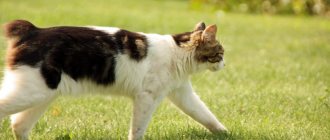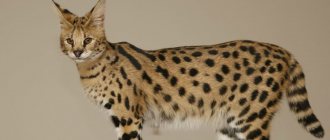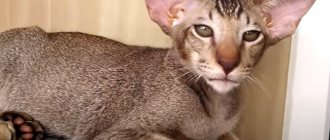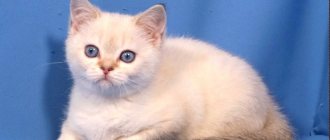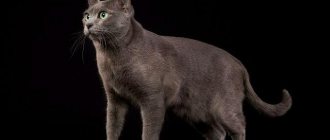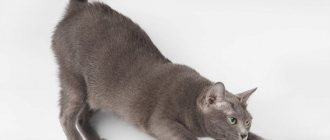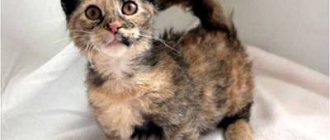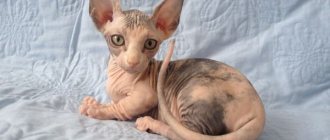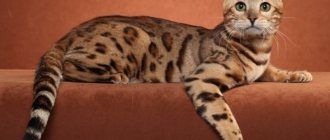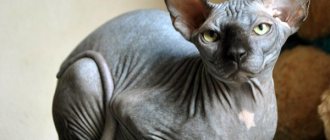History of the origin of the breed
The homeland of the Havana Brown breed is England. Her ancestors were Siamese cats with a uniform coat color. But after the introduction of standards, according to which only colorpoint colors with blue eyes were available, this breed lost its popularity and was partially lost.
However, in 1950, thanks to Baroness Miranda von Ullmann, work began on developing the Havana breed. For these purposes, Siamese cats were crossed with black shorthairs and already in 1959 they achieved success. In the same year, the breed standard was adopted and it was given a name. Previously, Havanas were referred to as “brown shorthairs.” Graceful cats were presented at the English exhibition.
In the 1960s, experiments were already underway in England with crossbreeding with colored Oriental cats, which gave rise to another breed called “Chocolate Oriental cats.”
At the same time, Havanas were brought to the United States, where the breed was preserved and continued to be bred.
Breed distribution and kitten cost
Most Havana Brown nurseries are located in the United States, with only a small number based in Europe. The breed is practically not widespread in Russia - this cat is for true connoisseurs and cat “gourmets”, of which there are not so many among Russians. The average price for a pet-class kitten is at least a thousand euros; accordingly, a cat for breeding will cost even more.
Standards
According to the standards of the Federation of Felinologists CFA, the Havana Brown must have many characteristics unique to this breed:
| Standard | Description |
| Limbs | Slender, long, with well-defined muscles, with the hind legs being somewhat longer than the front ones. The paw itself is small, oval. It is noteworthy that females have thinner and neater limbs compared to males. |
| Tail | It has a medium length, evenly tapering towards the end. |
| Head | Elongated in length, with a large, square chin and a narrow muzzle. Adult males have very pronounced cheeks and cheekbones. A distinctive feature is the sharp transition in the mustache area. |
| Neck | Strong, medium length. |
| Ears | Wide apart, large, slightly inclined forward. One gets the impression that the animal is constantly wary. There is a well-defined protective hair inside the ear. |
| Nose | Brown-pink, like the pads on the paws, and located almost at right angles to the chin. |
| Eyes | They are almond-shaped and medium in size, set wide apart. As for color, all shades of green are acceptable for the Havana breed, most often saturated ones. |
| Torso | Characterized by the presence of muscles, quite dense, of medium size. Cats are often larger than cats. |
| Wool | Smooth, shiny, has short to medium length hair. A distinctive feature is the uniformity of color. |
According to the CFA system, cats participating in exhibitions are assigned a certain title. It depends on the age of the competitor, the brightness of the color and physical characteristics. Once assigned, the owner of the animal is issued a title certificate.
Characteristics
One can only admire the manners of Havana! She behaves very well in public, does not create mischief in the house and responds friendly to affection. This breed has truly aristocratic character traits, which are matched by the unusual, rare appearance of the animal.
Appearance
The Havana is distinguished by its grace and has a firm gait, despite the fact that the cat itself is quite large. Her appearance captivates at first sight. It seems that everything about her is perfect.
The animal's muzzle is much narrower than the upper part of the head, the chin is strong, and there is a stop (fracture) at the transition from the forehead to the nose. The eyes captivate with their openness and emerald hue, and the coat glistens in the light of the sun.
The breed in question is the only one that has a defined whisker color standard. In lilac-colored cats they should be lilac, while in chocolate beauties they should be exclusively brown.
Weight and dimensions
An adult weighs about 4-6 kg. Males are usually heavier and larger than females. Havana has well-developed muscles and strong posture, although it appears lightweight.
Features of color
The color of this cat breed is rich and includes all shades of warm brown tones. The coat color is uniform and shiny. The standard also allows for purple colors with a gray tint. At the same time, the color of the mustache is always in harmony with the color of the coat, and the eyes can be all shades of green.
Kittens of this breed and young individuals may have a residual tabby pattern. With age, it completely disappears.
Lifespan
The lifespan of a cat depends on many factors: its pedigree, the presence of chronic diseases and, of course, living conditions. With proper care, a chocolate beauty can live 15-17 years.
Description of Havana cats
global $ads_google;
//data-ad-slot=”2475549904″ $ads_google = empty($ads_google) ? false : true; ?> if ($ads_google == false) {?> $ads_google = true; ?> } ?> The Havana cat is a graceful, medium-sized animal. It is heavier than it appears from its appearance. This is due to her well-developed muscles and minimal fat layer. The weight of an adult cat is about 3–4 kg. Cats are a kilogram heavier.
The felinological organization TICA has developed a breed standard, which includes its detailed description. Compliance with these criteria allows a cat to be called a Havana:
- Head. The skull is slightly elongated: its width is less than its length. A pronounced chin with some hair on it. In profile, a soft bend in the bridge of the nose is noticeable. Expressive and prominent cheekbones. Viewed from the front, the muzzle has a slightly rounded shape. Attention is also paid to the whiskers: they should be either chocolate or lilac in order to blend organically with the coat color. Nose – pink.
- Large ears are set wide on the head. The ears are tilted forward at a slight angle, and their apex is neatly rounded. The presence of hair, as on the chin, is minimal.
- The almond-shaped large eyes are green. Various shades of it are allowed. The color of a kitten's eyes often changes over time, acquiring its final shade only by one year.
- The body is strong, with well-developed muscles, but without prominent relief. The sizes of its parts are proportional, the cat looks slender.
- The legs are long, with the hind legs being longer than the front legs.
- The length of the elongated tail, gradually tapering towards the tip, is average. It is also not wide at the base.
- The short coat is smooth and shiny, and in healthy cats it shines in the light.
Young animals sometimes have tabby markings, but as they mature, such markings should disappear. The fur coat of an adult Havana cat is often warm brown in color with a reddish-brown tint, and less often – gray-lilac.
Character and behavior
Havana's behavioral characteristics are evident in everything. These animals are very energetic and inquisitive. When you decide to buy a Havana cat, remember that you will have to do everything together. Don't be surprised if you find your pet in the most unusual places - in a laundry basket, a pantry, or a bag brought from the store. At the same time, the animal is unobtrusive and self-sufficient.
Felinologists know that the Havana breed is distinguished by its nobility and refinement of manners and quite developed intelligence. She will not cause mischief in the house or take revenge on the owner. On the contrary, such cats love order: they eat food strictly in the feeding area and quickly get used to the cat litter box.
In addition, these cats love heights. Once on top of a cabinet or shelf, the pet will observe what is happening in the house.
The Havana is good-natured and affectionate with its owner, it can even stroke a person with its paw. Note that the paws are its main advantage. The predatory origin allows the cat to pick up objects with its claw in order to properly see and smell them.
Communication with a person is very important for this socialized animal - the cat sees him not only as an owner, but also as a friend. The Havana also easily gets along with other animals in the house, especially its blood relatives – Siamese and Orientals.
Photo of a Havana Brown cat
Character
Havana is very people-oriented. The breed was created for those who want to acquire a sociable, affectionate and intelligent friend in a cat. Like other cats from the Siamese-Oriental group, Havanas are very talkative and boast a variety of sounds. In addition to words, they may use their paws to get attention or when exploring a new object. They can be quite demanding if they are not given enough attention.
Most reviews about the breed are very positive. They describe Havanas as intelligent, active, kind and sociable cats designed to live in human society.
Curiosity forces the Havana to participate in all household chores. There are simply no things that would not arouse her interest. Havana can be a good friend for a child who knows how to treat animals with respect. She gets along well with other animals, cats and friendly dogs.
Care instructions
Grooming this short-haired cat requires minimal time and effort. The main task is to choose the right diet, care for the coat and carry out mandatory hygiene procedures.
Wool
The fur needs to be combed regularly, and the animal is unlikely to resist it. Once a week will be enough. But remember that the procedure will need to be carried out 2 times more often during molting.
Claws
Claw trimming is done to prevent the animal from injuring its owner or damaging the furniture in the house. There are several ways to achieve the goal:
- Trim nails regularly using special clippers.
- Purchase silicone claw covers that fit over the sharp edge of an animal’s claw and prevent unwanted scratches.
- Buy a scratching post. Perhaps this method is the most optimal and natural.
You need to get used to a scratching post from an early age, so take care of purchasing one in advance.
Ears
Once every 2 weeks, your cat's ears need to be cleaned. For this you will need regular cotton swabs. There is nothing complicated in the procedure, but it is extremely important not to damage the animal’s ear.
The precautions are as follows:
- It is better to carry out the procedure in the evening, when the cat is no longer so energetic and will not resist much;
- Fix the animal's head well. For these purposes, you can wrap the cat in a towel.
Remember, any careless movement can lead to ear injury. Take your time to complete the process as quickly as possible.
Bathing
You should not wash your cat too often - this breed does not need frequent water treatments and does not like them. It is enough to bathe the animal as it gets dirty and about once every 2-3 months for preventive purposes.
Naturally, this rule applies to pets that live at home. If the cat is walking, then you will have to wash it more often. In this case, you should use a special shampoo for cats.
As an exception, you can use baby shampoo if you did not have time to purchase a special product. However, this method is unsafe for the animal, because it can cause allergies and dry skin.
Teeth
For oral hygiene, you need to brush your teeth once every one and a half to two weeks. Because The Havana breed is prone to diseases of the gums and teeth; this rule should not be broken.
Eyes
Eye care should be done daily. To do this, you just need to wipe the corners of the animal’s eyes with a cotton swab dipped in warm water. In exceptional cases, if tearing occurs due to dust or for another reason, you can rinse your pet’s eyes with tea leaves.
Photo of a Havana Brown kitten
Catering
The health of a pet and its appearance, first of all, depend on the proper organization of its diet. Havana is unpretentious in its choice of food, but breeders advise feeding it with specialized super-premium food, because they do not contain artificial flavors or fragrances. At the same time, you should not get carried away with dry food alone. It is better to purchase food in the form of wet canned food. When choosing a natural diet, it is important to follow the rule: it must contain at least 70% meat products.
What type of food did you choose for your cat?
Store-bought feedNatural food
Recommended food
Below are recommended super-premium foods, links with food names are clickable. Using them, you can, within our website, read descriptions of food and read reviews from owners of Havana Brown cats.
| Holistic | Premium | Super premium |
| Gina Elite | DailyCat | Arden Grange |
The animal will also need clean drinking water, which the cat often likes to scoop up from its bowl with both paws at once.
Expert opinion
Dusheba Vera Ivanovna
In 2010, she graduated from the Moscow State Academy of Veterinary Medicine named after K.I. Scriabin with honors, specializing in veterinary medicine. I regularly attend veterinary conferences, congresses, and webinars.
Sterilized animals need control from the owner - due to the needs of the body, they are prone to overeating. Therefore, counting calories and a clear feeding schedule will be the solution to the problem.

